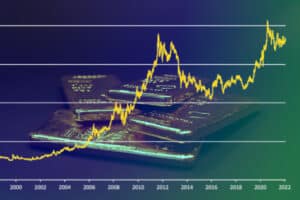In today’s fast-paced world, investors are constantly looking for new opportunities for growth and stability. Amidst the uncertainty caused by economic volatility and political tensions, understanding gold liquidity and market demand is becoming increasingly important.
The complex interplay between gold liquidity and market demand can be difficult to navigate without deeply understanding the underlying market factors. Keep reading to understand the gold market’s dynamics, empowering you to make informed investment decisions and secure your financial future.
The Concept Of Gold Liquidity
Gold liquidity is important for investors since it influences transaction efficiency, price stability, and overall market dynamics, shaping investment strategies and potential outcomes.
What Gold Liquidity Means
Gold liquidity is the ease with which investors can buy or sell gold. Gold is considered particularly liquid among precious metals due to its global trading and well-established market structure. Unlike other assets, such as real estate or collectibles, gold can be sold quickly and without much loss in value, making it a popular investment option for many people worldwide.
A highly liquid gold market means many buyers and sellers, allowing transactions to occur rapidly and smoothly. This liquidity enables investors to enter or exit positions conveniently without causing drastic price changes. It also reduces the spread between buy and sell prices, making transactions more cost-effective for traders.
On the other hand, a less liquid market may have fewer buyers and sellers, resulting in slower transactions, larger price impacts, and wider spreads. This can make it more challenging for investors to buy or sell gold without significantly affecting the price.
The World Gold Council measures gold liquidity by analyzing data derived from global commodity exchanges and over-the-counter markets and statistics on gold-backed products.
The Role Of Gold In The Global Market
One of gold’s most important functions is its wealth preservation abilities. In times of economic uncertainty or inflation, investors often turn to gold because it has historically maintained its value over time.
Gold also serves as a hedge against currency fluctuations, especially during geopolitical tension or when confidence in fiat currencies wanes. Its tangible nature and limited supply make it a sought-after asset for private and institutional investors worldwide.
Gold also has other tangible purposes, as it’s often used to make jewelry due to its luster, durability, and timeless appeal. The jewelry industry accounts for a significant portion of the global demand for gold.
The Impact Of Gold Liquidity On The Economy
In financial markets, high gold liquidity can contribute to market stability. Because gold is often viewed as a ‘safe haven,” its liquidity can influence investor confidence, especially during economic uncertainty. Investors can easily shift their funds into gold when gold is highly liquid, potentially smoothing market fluctuations.
Central banks often hold gold as part of their reserves, and gold’s liquidity can affect their ability to manage the value of their currencies and control inflation. In times of economic crisis, central banks may sell gold to inject liquidity into the economy.
In countries where gold mining is a significant part of the economy, gold liquidity can directly impact economic health. When gold is highly liquid, it can be sold more easily on world markets, increasing export revenues for these countries.
The Interplay Between Gold Liquidity And Gold Prices
Gold liquidity and prices are interrelated, with changes in one factor affecting the other. High gold liquidity, characterized by extensive trading activity and high gold demand, can drive up prices due to increased buying pressure and competition. Conversely, low liquidity can lead to lower demand and potentially lower prices.
While the demand for gold is influenced by its use in jewelry, industrial applications, investment, and central bank activity, the supply is determined by mining activity and the availability of recycled gold. The level of supply and demand can significantly impact the price of gold and the overall dynamics of the gold market.
When supply is tight or demand increases, the liquidity of gold can increase, leading to higher prices. For example, demand for gold as a safe-haven asset during economic uncertainty or geopolitical risks tends to increase, leading to higher prices.
Conversely, when gold supply increases or demand declines, the liquidity of gold can decrease, leading to lower prices. For instance, if gold mining activities increase significantly, the supply of gold in the market can also increase, leading to lower prices if demand does not increase proportionally.
Factors Influencing Gold’s Market Demand
The demand for gold is driven by investment, industrial, ornamental, and central bank activities. By understanding these drivers, you can gain valuable insights into the gold market’s dynamics and potential investment opportunities.
Economic Instability And Global Crises
Gold tends to be viewed as a safer asset during times of instability and is often sought after by investors looking to protect their wealth. Investors often turn to safe haven assets like gold during economic instability or global crises.
The 2008 financial crisis is a prime example of this. When stock markets crashed and fears about the global economy were widespread, demand for gold skyrocketed as many investors sought the relative safety that gold offers.
Global crises can also affect the price of gold by changing the dynamics of supply and demand. For instance, conflicts or disruptions in key mining regions can reduce supply while increasing demand for safe assets like gold. This can drive up the price of gold.
Inflation And Interest Rates
In times of high inflation, the purchasing power of money decreases, leading to higher costs for goods and services. This situation can cause investors to worry about the loss of value of their cash holdings. As a result, they often look for safe investments to protect themselves from this loss of value.
Gold, long known as a store of value, becomes an attractive option in such scenarios. Unlike paper money, its value doesn’t decline with the rising cost of living. This perception drives up demand for gold in inflationary times, which can lead to a rise in the price of gold.
On the other hand, the purchasing power of money remains relatively stable during periods of low inflation or deflation. This stability reduces the urgency for investors to hedge against inflation, leading to a decline in gold demand.
High-yielding assets such as bonds and savings accounts become more attractive when interest rates are high, potentially drawing investors away from non-interest-bearing assets such as gold. Conversely, gold becomes more attractive in a low-interest rate environment as the opportunity cost of owning gold decreases.
The Impact Of Central Bank Reserves
Central banks worldwide hold gold as part of their reserves to back their respective currencies and manage economic uncertainties. Their buying and selling activities can significantly influence the demand for gold in the market.
During periods of economic stability, central banks might increase their gold reserves as a long-term investment and a hedge against potential future crises. Conversely, central banks might sell part of their gold reserves during financial problems to inject liquidity into the economy.
In recent years, central banks worldwide have shown increased interest in acquiring gold as part of their reserves. This surge in demand has positively impacted the overall liquidity and value of gold, and as a result, gold demand from central banks peaked at 1,136 tons in 2022 alone. This strong demand continued in 2023, reaching a new record level in the first quarter.
Industrial Demand’s Role
Various industries value gold for its unique properties, such as electrical conductivity and corrosion resistance. Industries ranging from electronics to dentistry and aerospace extensively use gold in their manufacturing processes.
For instance, gold is used in electronic devices for its conductivity, in dentistry for its biocompatibility, and in aerospace for its resistance to radiation. Though the industrial sector’s share may be smaller than jewelry or investment, it still significantly contributes to the annual global demand for gold.
Future Trends And Predictions
The future of gold liquidity and market demand is influenced by several trends and forecasts as the global economy continues to evolve. These factors offer investors important insights that can help formulate sound investment strategies.
Rising Demand From Emerging Economies
Emerging markets, particularly India and China, are anticipated to fuel the demand for gold in the future. These regions have a deep-rooted cultural connection with gold, with gold jewelry and ornaments integral to their customs and traditions.
As these regions continue their economic growth, income levels are expected to rise. This increase in disposable income will likely boost the demand for gold jewelry, contributing to the overall rise in gold demand.
A growing middle class could also drive investment demand for gold, adding to the metal’s overall market demand.
Impacts Of Global Crises
The world faces multiple crises, ranging from climate change to political conflicts and pandemics. These crises have caused significant disruptions to the global economy, leading to increased demand for safe-haven assets.
As the world grapples with these crises, the demand for gold is expected to remain robust or even rise. Investors increasingly seek refuge in the precious metal, with many turning to gold as a safe haven asset. This has increased liquidity in the gold market, driving up gold prices.
The ongoing COVID-19 pandemic has also had a significant impact on the demand for gold. As the pandemic continues ravaging economies worldwide, investors are seeking out safe-haven assets to protect their wealth.
Technological Advancements
Technological advancements are set to shape the future of gold liquidity. Innovations in trading platforms, such as blockchain-based systems, are expected to enhance transparency and increase liquidity in the gold market.
With increased liquidity, gold trading could become more efficient and cost-effective, stimulating demand. Technological advancements could also open up new avenues for gold usage, particularly in industries like electronics and healthcare, thereby potentially increasing gold’s market demand.
Invest In Precious Metals Today
If you’re looking to stay ahead of the game and invest in an asset class that’s proven to hedge against economic uncertainty, investing in precious metals has been a popular option among investors for decades.
Whether you’re interested in physically storing your investments at home or in a tax-advantaged precious metals IRA, Noble Gold Investments offers a wide range of gold, silver, platinum, and palladium bars and coins to choose from. Give us a call today at (877) 646-5347, or click here to open an account online.







